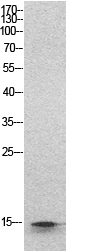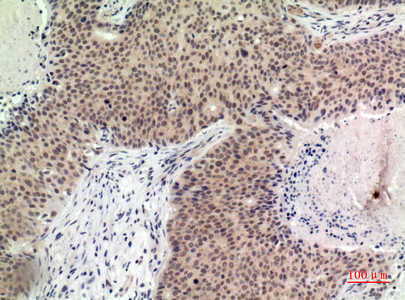

| WB | 咨询技术 | Human,Mouse,Rat |
| IF | 咨询技术 | Human,Mouse,Rat |
| IHC | 1/50-1/100 | Human,Mouse,Rat |
| ICC | 技术咨询 | Human,Mouse,Rat |
| FCM | 咨询技术 | Human,Mouse,Rat |
| Elisa | 1/10000 | Human,Mouse,Rat |
| Aliases | HIST1H2BB; H2BFF; Histone H2B type 1-B; Histone H2B.1; Histone H2B.f; H2B/f; HIST1H2BC; H2BFL; HIST1H2BE; H2BFH; HIST1H2BF; H2BFG; HIST1H2BG; H2BFA; HIST1H2BI; H2BFK; Histone H2B type 1-C/E/F/G/I; Histone H2B.1 A; Histone H2B.a; H2B/a; Histone H2B.g; H2B/g; Histone H2B.h; H2B/h; Histone H2B.k; H2B/k; Histone H2B.l; H2B/l; HIST1H2BD; H2BFB; HIRIP2; Histone H2B type 1-D; HIRA-interacting protein 2; Histone H2B.1 B; Histone H2B.b; H2B/b; HIST1H2BH; H2BFJ; Histone H2B type 1-H; Histone H2B.j; H2B/j; HIST1H2BJ; H2BFR; Histone H2B type 1-J; Histone H2B.1; Histone H2B.r; H2B/r; HIST1H2BK; H2BFT; HIRIP1; Histone H2B type 1-K; H2B K; HIRA-interacting protein 1; HIST1H2BL; H2BFC; Histone H2B type 1-L; Histone H2B.c; H2B/c; HIST1H2BM; H2BFE; Histone H2B type 1-M; Histone H2B.e; H2B/e; HIST1H2BN; H2BFD; Histone H2B type 1-N; Histone H2B.d; H2B/d; HIST1H2BO; H2BFH; H2BFN; Histone H2B type 1-O; Histone H2B.2; Histone H2B.n; H2B/n |
| Entrez GeneID | 3017/8339/8343/8344/8346/8347/3018/8345/85236/8340/8342/8341/440689 |
| WB Predicted band size | Calculated MW: 14 kDa; Observed MW: 14 kDa |
| Host/Isotype | Rabbit IgG |
| Antibody Type | Primary antibody |
| Storage | Store at 4°C short term. Aliquot and store at -20°C long term. Avoid freeze/thaw cycles. |
| Species Reactivity | Human,Mouse,Rat |
| Immunogen | Synthesized peptide derived from the Internal region of human Histone H2B. |
| Formulation | Purified antibody in PBS with 0.05% sodium azide,0.5%BSA and 50% glycerol. |
+ +
以下是3篇关于Angiopoietin-1(Ang1)抗体的代表性文献摘要,供参考:
---
1. **文献名称**: *Angiopoietin-1 protects the adult vasculature against plasma leakage*
**作者**: Thurston G, et al.
**摘要**: 研究利用Ang1特异性抗体及重组Ang1蛋白,发现Ang1通过激活Tie2受体稳定血管内皮细胞连接,减少炎症或VEGF诱导的血管渗漏,为治疗血管通透性相关疾病(如水肿或败血症)提供理论依据。
2. **文献名称**: *The role of Angiopoietin-1 in neovascularization and hematopoiesis*
**作者**: Suri C, et al.
**摘要**: 通过基因敲除和Ang1抗体阻断实验,证实Ang1在胚胎血管发育和造血干细胞微环境中的关键作用,并揭示其通过调控内皮细胞与周细胞相互作用维持血管完整性。
3. **文献名称**: *Therapeutic targeting of Angiopoietin-1 inhibits tumor growth in a preclinical model of melanoma*
**作者**: Hawighorst H, et al.
**摘要**: 使用Ang1中和抗体阻断肿瘤微环境中的Ang1/Tie2信号通路,显著抑制黑色素瘤小鼠模型的血管生成和肿瘤生长,提示Ang1抗体在抗肿瘤治疗中的潜力。
---
以上文献可进一步在PubMed或Web of Science通过标题或作者检索获取全文。如需更近期研究,建议补充关键词(如“Ang1 antibody therapeutic”或“Angiopoietin-1 inhibitor”)进行数据库筛选。
Angiopoietin-1 (Ang1) is a key secretory glycoprotein involved in vascular development and stability, primarily signaling through the Tie2 receptor tyrosine kinase. It plays a critical role in regulating endothelial cell survival, vascular maturation, and quiescence by promoting cell-cell interactions and reducing vascular permeability. Ang1 is structurally characterized by its coiled-coil oligomerization domain and fibrinogen-like receptor-binding domain. Dysregulation of Ang1 signaling is implicated in pathological conditions such as tumor angiogenesis, inflammatory disorders, and cardiovascular diseases.
Antibodies targeting Ang1 are essential tools for studying its biological functions and therapeutic potential. These antibodies, including monoclonal and polyclonal variants, are designed to detect, neutralize, or modulate Ang1 activity in experimental and clinical settings. In research, they are widely used in techniques like ELISA, Western blotting, immunohistochemistry, and flow cytometry to quantify Ang1 expression or assess its interaction with Tie2. Neutralizing antibodies, which block Ang1-Tie2 binding, help investigate angiogenesis pathways or evaluate Ang1's role in disease models, such as cancer progression or vascular leakage syndromes. Conversely, agonist antibodies mimicking Ang1 activity may promote vascular stabilization in conditions like diabetic retinopathy or sepsis.
Therapeutic applications of Ang1 antibodies are being explored in preclinical studies, particularly for anti-angiogenic cancer therapies or mitigating inflammation-driven vascular damage. However, challenges remain in balancing pro- and anti-angiogenic effects, given the context-dependent roles of Ang1 and its antagonist Ang2 in vascular homeostasis.
×